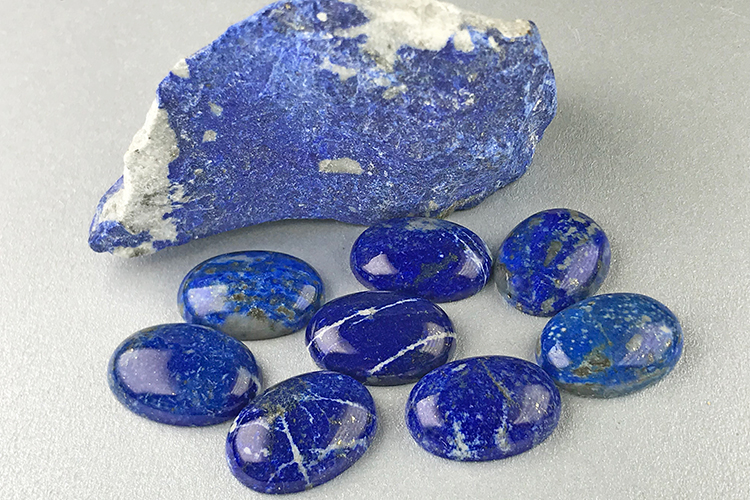Guide to Lapis Lazuli

History, Lore and Appreciation
Technically, lapis lazuli is a rock since several minerals combine to form it, with lazurite being its principal component, and giving the material its deep blue color. It is, in fact lapis lazuli’s intense blue color, at times flecked with white calcite and golden colored pyrite crystals that has captivated people’s attention for thousands of years. The Assyrians and Babylonians prized lapis lazuli for use as carved seals.
It was used throughout many of Egypt’s dynasties, and was referred to by them as “heaven’s stone.” Pharaoh Cleopatra VII had a particular affinity for it; aside from using it in jewelry and as an inlay for artefacts, she had it (or lazurite crystals from the same source) ground into a powder, which could then be emulsified for use as eye shadow makeup. Further, it was used as a blue pigment (called ultramarine) for many centuries. It is thought that lapis lazuli was one of twelve gems that comprised the High Priest’s Breastplate – mentioned in the Book of Exodus – an account of when the Israelites left Egypt. Lapis Lazuli, which has long been mined in Afghanistan in an area travelled by merchants along the ancient Silk Road, spread appreciation for the blue gem in the Far East as well. Interestingly, the material was long described as sapphirus, meaning that what was known as such in ancient times was lapis lazuli – and not sapphire. An example is Pliny the Elder who used the word sapphirus in describing a blue gemstone with golden spots. Actually, lapis lazuli is thought to come from the Latin lapis, stone, and Persian lajevard, blue stone, literally meaning “stone blue stone”. It was first used with this meaning in the 17th century. It is important to bear in mind that, as far as blue gems were concerned, lapis lazuli was the blue gem to covet and cherish, long before blue sapphire came to be appreciated in the West. Today, lapis lazuli is valued as a bold ornamental gem that can be beaded, fashioned into cabochons, polished for inlays and carved.
Birthstones and Anniversaries
While lapis lazuli is not mentioned as a birthstone in modern lists, it was once suggested as an alternate gem for the month of December, together with turquoise. It is considered a 9th wedding anniversary gemstone.
Description and Properties
A rock composed primarily of lazurite, calcite and pyrite. It may also contain haüynite, sodalite, and diopside.
Color(s): Medium to dark, slightly greenish blue to purplish blue, often containing metallic looking pyrite crystals and/or white to grey flecks of calcite.
Refractive Index: 1.50 or 1.67 (with lots of calcite); it can be challenging to obtain a refractive index reading for lapis lazuli.
Birefringence: None
Specific Gravity: 2.75 (±0.25) (This may vary due to mineral content).
Cause(s) of color: In lazurite, sulphur- related color centres.
Mohs Hardness: 5 to 6 (variations due to composition).
Internal identifying characteristics: randomly scattered pyrite crystals (that appear as yellow metallic flecks) and mottled white calcite crystals.
Treatments
Dyeing: Lapis lazuli, which is naturally porous, is easily dyed to deepen the color and give the stone a more uniform appearance.
Coating or impregnation: This treatment using colorless paraffin, wax or resins sometimes follows dyeing in an attempt to seal the gem surface, continue to deepen the color and help improve its polish.
Oiling: Some lapis lazuli may be treated with oil in an attempt to deepen its color.
Collector Quality
Lapis lazuli that is naturally deep and uniformly blue in color, is the most collectible form of the gem material. Care must be taken to determine it has been dyed. If so, it is not considered collectible quality. Some collectors appreciate a discreet spray of pyrite crystals, which serve as further proof of the gem’s natural origin, though calcite’s mottled white flecks are not as well appreciated. Because of lapis lazuli’s ancient past, jewels with known provenance are considered collectible. Carvings, seals, inlays and intaglios that have been fashioned by known artists are also collectible.
Localities
Afghanistan’s mountainous North- eastern area of Badakhshan, notably in Sar-e-Sang, is the world’s most famous locality. It still produces the standard qualities by which other sources are compared. Deposits in Iran, Chile and Russia produce lighter, less saturated varieties of lapis lazuli.
Cutting, Care and Cleaning
Lapis lazuli is generally cut in the form of cabochons or tablets, and these cuts wear well since they have no sharp edges to abrade. Beads also wear well for the same reason. Free form cuts and carvings of lapis lazuli are also popular. A soft damp cloth is ideal for cleaning the gem and because it is naturally porous, lapis lazuli should be kept away from substances that could permeate the gem’s surface. Nail polish remover (acetone) and other chemicals may damage dyed material.
Source: CIBJO Retailer Reference Guide, cibjo.org.